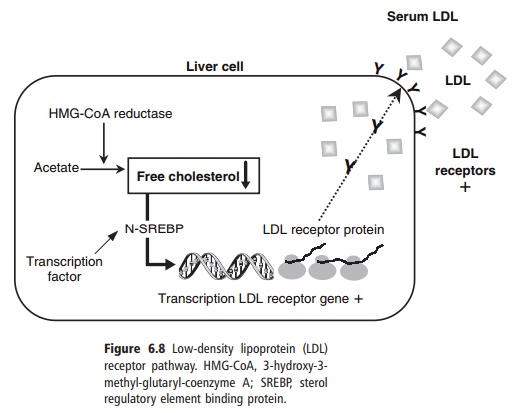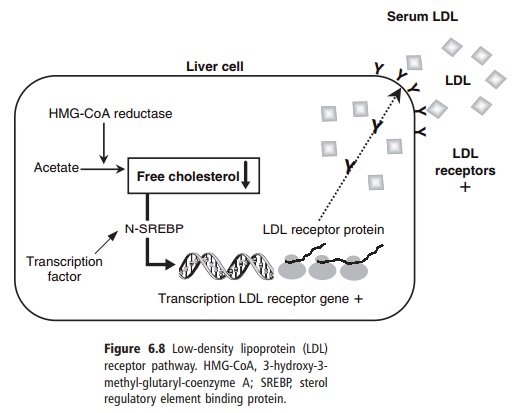Chapter: Introduction to Human Nutrition: Nutrition and Metabolism of Lipids
Low-density lipoprotein receptor pathway

The low-density lipoprotein
receptor pathway
The incontrovertible link between plasma cholesterol and CHD is
directly responsible for the rapid growth, and occasional quantum leaps, in our
understanding of cholesterol homeostasis in relation to diet and

All cells, most notably those in the liver, have a highly developed and
sensitive mechanism for regulating intracellular and intravascular levels of
cholesterol. Cells in the liver synthesize approximately 500 mg of cholesterol a
day and, although they can import the same quantity from the blood in the form
of LDL, in the complete absence of LDL, cells could theoretically manufacture
sufficient cholesterol to meet their met-abolic needs. However, when stressed,
cells will always import cholesterol in preference to synthesizing it
themselves as the former process takes less energy. Cells acquire cholesterol
from the blood by the uptake and degradation of LDL particles. As the
requirement for free cholesterol increases within the cell, it increases its
production and thus activity of LDL receptors, so that more LDL is extracted
from the blood, lowering blood cholesterol. Conversely, if the cell becomes
overloaded with cholesterol, it senses that it requires less cholesterol and
produces fewer LDL receptors, causing blood cholesterol to increase. Since the
pro-duction of LDL receptors is regulated by the intracel-lular level of free
cholesterol, anything that increases free cholesterol within the cell will
inadvertently lower blood LDL cholesterol. Intracellular free cholesterol
represses the activity of a sterol regulatory element binding protein (SREBP),
a positive nuclear tran-scription factor that promotes the transcription of the
LDL receptor gene when free cholesterol levels fall.
The metabolic effects of intracellular free cholesterol are:
● it decreases the production of LDL receptors via SREBP
● it inhibits the synthesis of cholesterol by the enzyme
3-hydroxy-3-methylglutaryl (HMG)-CoA reductase
● it increases the re-esterification of cholesterol for storage as
cholesterol esters.
Goldstein and Brown were aided in the discovery of the LDL
receptor by studying a condition known as familial hypercholesterolemia, a
genetic abnormal-ity in the LDL receptor gene that produces defects in the LDL
receptor pathway and considerably elevated blood cholesterol concentrations in
early life (15– 20 mmol/l) and premature cardiovascular disease. They also
initiated pioneering studies on the influ-ence of dietary fats on the activity
of the LDL pathway, which led to a widely accepted explanation for the
cholesterol-raising properties of saturated fatty acids.
Related Topics